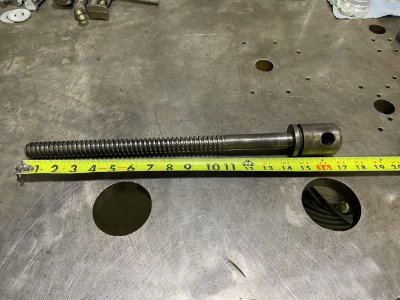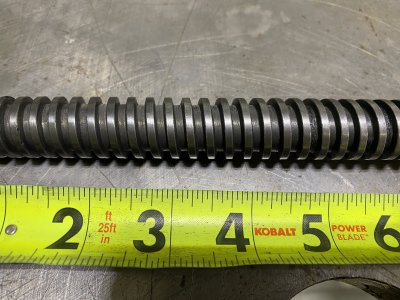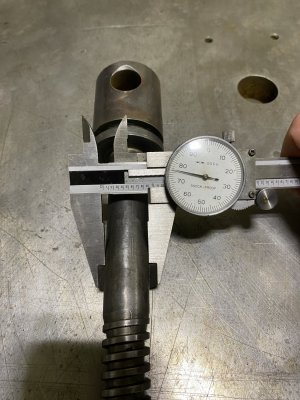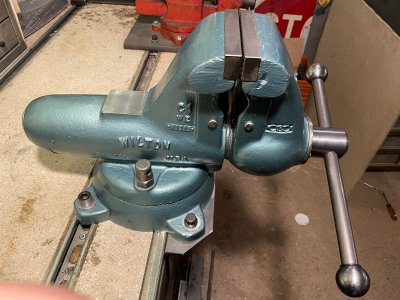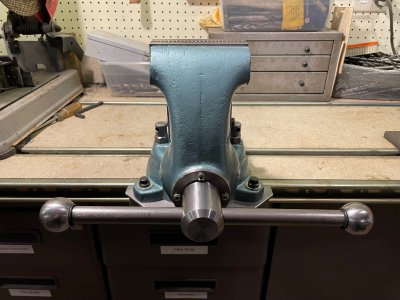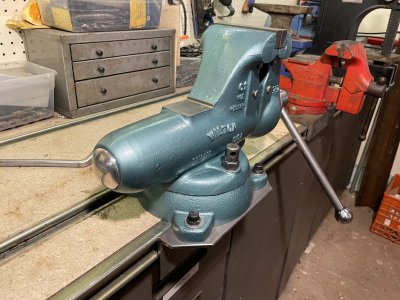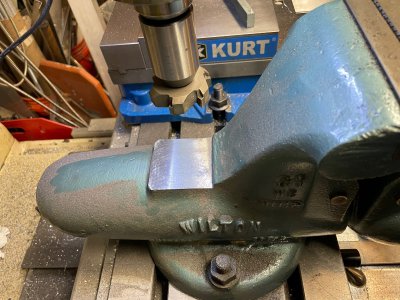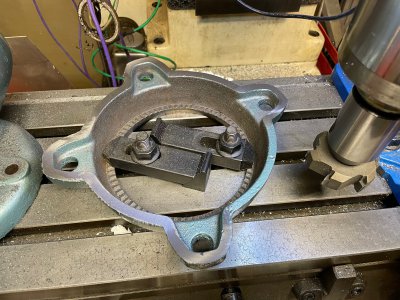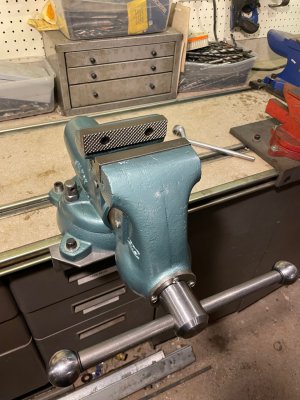- Joined
- Dec 24, 2020
- Messages
- 1,038
Being a vise guy, this is a repair I've made multiple times and there are a couple of ways to go about it.
Ideally you cut everything off flush at the back of the spindle so that's all you're left with. Face the back of the spindle, then bore a hole into the spindle an inch or so and give it a heavy countersink at the mouth. The bore diameter doesn't matter as you're going to turn the screw to fit. Then get a length of something like 8620 which can be welded, thread most of it, and leave several inches smooth so that section will ride in the dynamic jaw without causing wear. Turn down an inch of the smooth section to match the bore you made in the spindle so it's a press fit. Press the spindle in and run a TIG bead around the area when you countersunk. Next you drill a hole through the bottom of the groove in the spindle (where the horseshoe washer rides) and drill through the part you just pressed and welded in place. Drive in a cross pin that sits just below flush, and put a TIG plug weld to hold it in place...smooth that off with a file if necessary. You now have it welded and cross-pinned and it's not going to fail. Depending upon your vise, it could be possible to do it with just all-thread that doesn't have a smooth section...you'd just have to see how the fit between the spindle and they dynamic jaw is where the spindle passes through behind the horseshoe collar.
Another method is to cut off the threaded section, buy a new threaded section and weld them together. I like to center drill then drill each half to accept a dowel pin to keep them in alignment. V both sides, join them with the dowel pin and put that all in a vise with V blocks holding them until you can tack weld the assembly several times around the perimeter. Once tack welded you can just fill in the groove and turn down any excess. I tend to think the first method is a bit more foolproof and stronger since it doesn't really rely much on the weld strength. I've heard of people just boring and cross pinning without adding the welds and they held up fine, but I like adding the welds just in case.
The third option is to find you friendly vise guy forum member who probably has a couple of Wilton C1 spindles on the shelf that are in useable condition. I'm almost positive I do and can check if you'd be interested...at a fraction of the new cost from JPW. I might even have one with the handle already removed so it would be cheaper to ship....pretty sure you could tackle the handle replacement. The ball ends on your current handle are swaged in place. All you have to do is carefully grind the end and you can drive the ball end off and when you mount it on the new spindle just run a small plug weld over the spot your ground off and smooth with an angle grinder.
BTW, your C1 was made prior to 1957 when Wilton left Chicago proper for Schiller Park (near the current Chicago airport).
For anybody interested, I have an article on how to find the date of Wilton vises on my website:
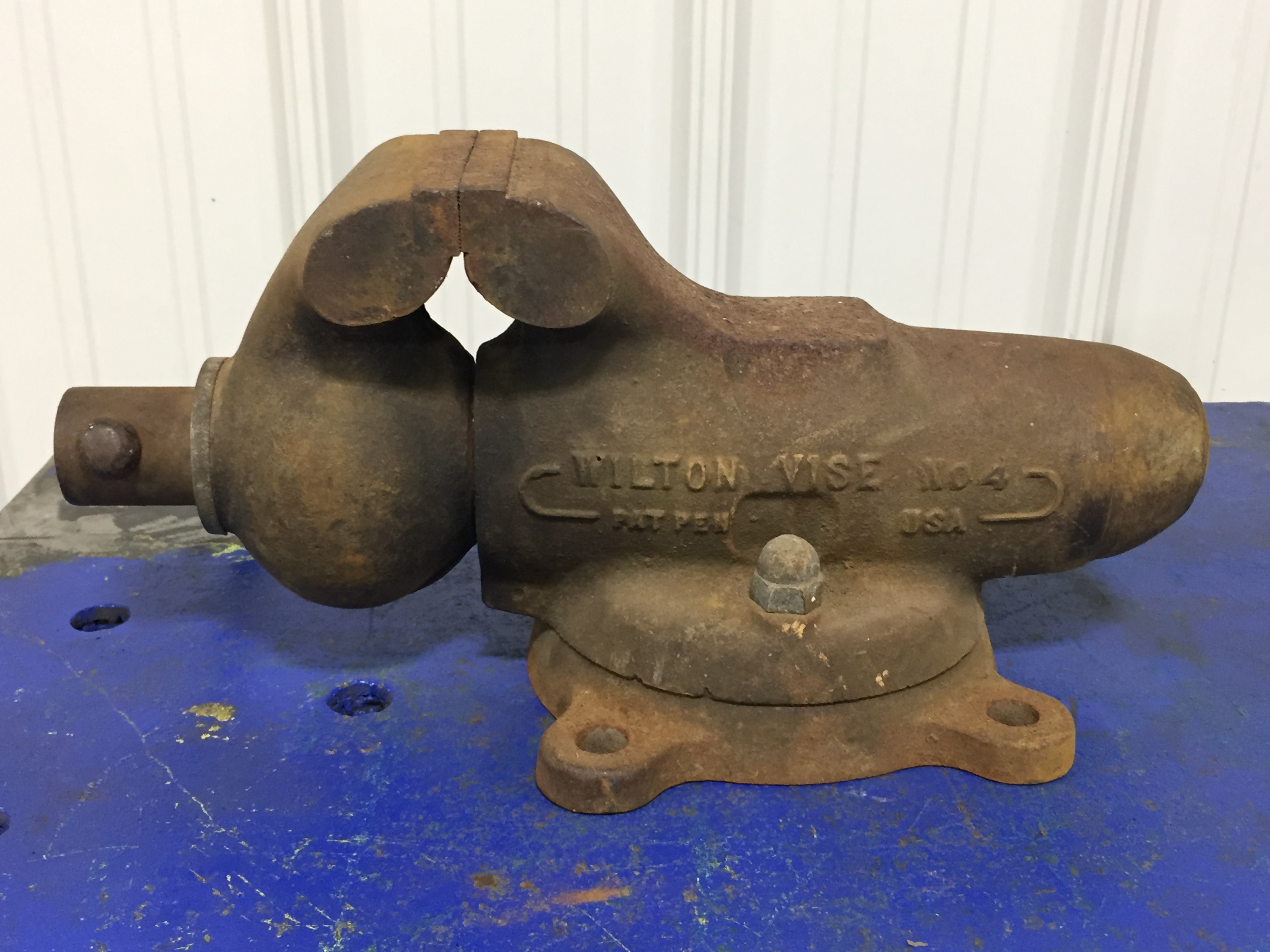
 mivise.com
mivise.com
Ideally you cut everything off flush at the back of the spindle so that's all you're left with. Face the back of the spindle, then bore a hole into the spindle an inch or so and give it a heavy countersink at the mouth. The bore diameter doesn't matter as you're going to turn the screw to fit. Then get a length of something like 8620 which can be welded, thread most of it, and leave several inches smooth so that section will ride in the dynamic jaw without causing wear. Turn down an inch of the smooth section to match the bore you made in the spindle so it's a press fit. Press the spindle in and run a TIG bead around the area when you countersunk. Next you drill a hole through the bottom of the groove in the spindle (where the horseshoe washer rides) and drill through the part you just pressed and welded in place. Drive in a cross pin that sits just below flush, and put a TIG plug weld to hold it in place...smooth that off with a file if necessary. You now have it welded and cross-pinned and it's not going to fail. Depending upon your vise, it could be possible to do it with just all-thread that doesn't have a smooth section...you'd just have to see how the fit between the spindle and they dynamic jaw is where the spindle passes through behind the horseshoe collar.
Another method is to cut off the threaded section, buy a new threaded section and weld them together. I like to center drill then drill each half to accept a dowel pin to keep them in alignment. V both sides, join them with the dowel pin and put that all in a vise with V blocks holding them until you can tack weld the assembly several times around the perimeter. Once tack welded you can just fill in the groove and turn down any excess. I tend to think the first method is a bit more foolproof and stronger since it doesn't really rely much on the weld strength. I've heard of people just boring and cross pinning without adding the welds and they held up fine, but I like adding the welds just in case.
The third option is to find you friendly vise guy forum member who probably has a couple of Wilton C1 spindles on the shelf that are in useable condition. I'm almost positive I do and can check if you'd be interested...at a fraction of the new cost from JPW. I might even have one with the handle already removed so it would be cheaper to ship....pretty sure you could tackle the handle replacement. The ball ends on your current handle are swaged in place. All you have to do is carefully grind the end and you can drive the ball end off and when you mount it on the new spindle just run a small plug weld over the spot your ground off and smooth with an angle grinder.
BTW, your C1 was made prior to 1957 when Wilton left Chicago proper for Schiller Park (near the current Chicago airport).
For anybody interested, I have an article on how to find the date of Wilton vises on my website:

Wilton Vise Date Stamping • MIVise
***Note: If you’re reading this post so you can cut and paste portions for your eBay listing please be kind enough to cite the source. There were a lot of people before me who put time into collecting this information and they should at least be given credit.*** One of the most common questions...
Last edited:


 Pulled the Acme stud out and had a perfect spiral chip that was left of the piece inside . Just thought you would get a laugh out of this . On the other hand , we'll check out the $$$ for a replacement piece or have to buy a new vise . I'm going to advise them to give it to the scrap man ............................................which is me .
Pulled the Acme stud out and had a perfect spiral chip that was left of the piece inside . Just thought you would get a laugh out of this . On the other hand , we'll check out the $$$ for a replacement piece or have to buy a new vise . I'm going to advise them to give it to the scrap man ............................................which is me . 